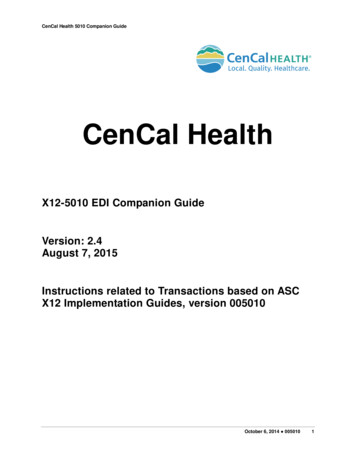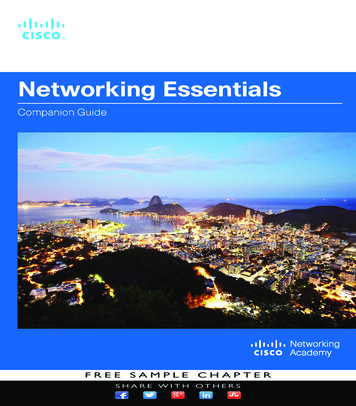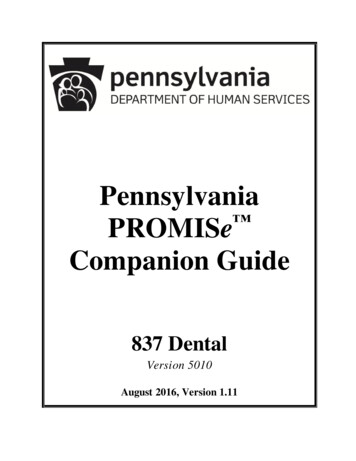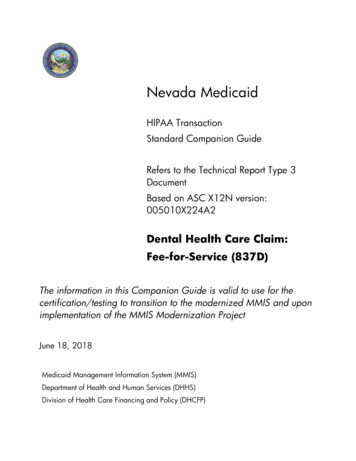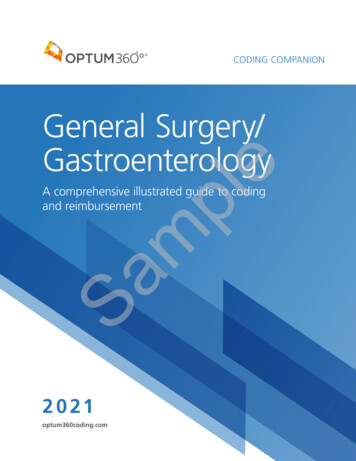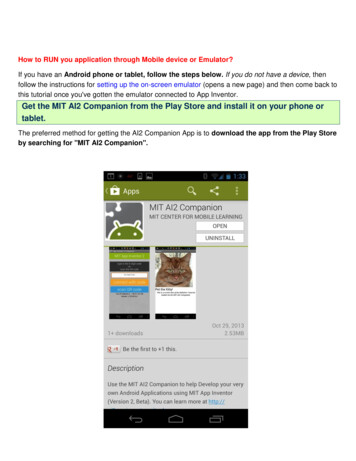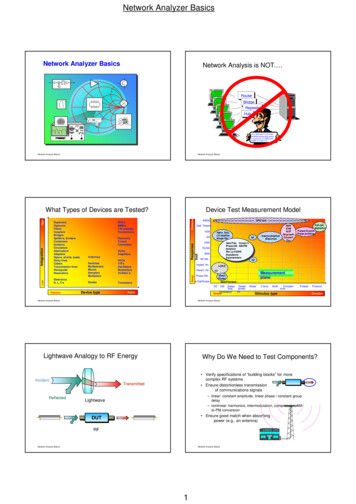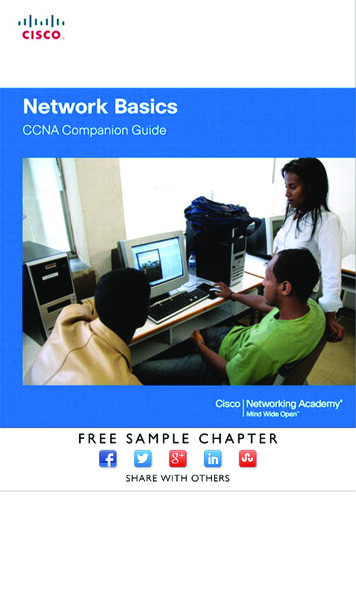
Transcription
Network BasicsCompanion GuideCisco Networking AcademyCisco Press800 East 96th StreetIndianapolis, Indiana 46240 USA
iiNetwork Basics Companion GuideNetwork Basics Companion GuideCopyright 2014 Cisco Systems, Inc.Published by:Cisco Press800 East 96th StreetIndianapolis, IN 46240 USAAll rights reserved. No part of this book may be reproduced or transmitted inany form or by any means, electronic or mechanical, including photocopying,recording, or by any information storage and retrieval system, without writtenpermission from the publisher, except for the inclusion of brief quotations ina review.Printed in the United States of AmericaFirst Printing November 2013Library of Congress Cataloging-in-Publication data is on file.ISBN-13: 978-1-58713-317-6PublisherPaul BogerAssociate PublisherDave DusthimerBusiness OperationManager, Cisco PressJan CornelssenExecutive EditorMary Beth RayManaging EditorSandra SchroederDevelopment EditorEllie C. BruProject EditorMandie FrankCopy EditorBill McManusISBN-10: 1-58713-317-2Technical EditorTony ChenWarning and DisclaimerEditorial AssistantVanessa EvansThis book is designed to provide information about the Cisco NetworkingAcademy Network Basics course. Every effort has been made to make thisbook as complete and as accurate as possible, but no warranty or fitness isimplied.DesignerMark ShirarThe information is provided on an “as is” basis. The authors, Cisco Press, andCisco Systems, Inc. shall have neither liability nor responsibility to any personor entity with respect to any loss or damages arising from the informationcontained in this book or from the use of the discs or programs that mayaccompany it.IndexerKen JohnsonThe opinions expressed in this book belong to the author and are not necessarily those of Cisco Systems, Inc.CompositionTrina WurstProofreaderCharlotte Kughen
iiiTrademark AcknowledgmentsAll terms mentioned in this book that are known to be trademarks or service marks have been appropriately capitalized. Cisco Press or Cisco Systems, Inc., cannot attest to the accuracy of this information. Useof a term in this book should not be regarded as affecting the validity of any trademark or service mark.Corporate and Government SalesThe publisher offers excellent discounts on this book when ordered in quantity for bulk purchases orspecial sales, which may include electronic versions and/or custom covers and content particular to yourbusiness, training goals, marketing focus, and branding interests.For more information, please contact:U.S. Corporate and Government or sales outside the United States, please contact:International Salesinternational@pearsoned.comFeedback InformationAt Cisco Press, our goal is to create in-depth technical books of the highest quality and value. Eachbook is crafted with care and precision, undergoing rigorous development that involves the uniqueexpertise of members from the professional technical community.Readers’ feedback is a natural continuation of this process. If you have any comments regarding howwe could improve the quality of this book, or otherwise alter it to better suit your needs, you can contact us through email at feedback@ciscopress.com. Please make sure to include the book title and ISBNin your message.We greatly appreciate your assistance.
ivNetwork Basics Companion GuideAbout the Contributing AuthorsAntoon (Tony) W. Rufi is Campus Director of Academic Affairs, ECPI University,Newport News, Virginia. Tony is a networking professional who retired from theU.S. Air Force in June 2000 after 29 years. He worked on communication systems.Since retirement, Tony has worked for ECPI University teaching a variety of networking courses. The courses he has led include CCNA, CCNP, and Fundamentalsof Network Security in the Cisco Academy at ECPI University, as well as numerous courses in the university’s Cloud Computing program. Tony is a PhD candidate, Applied Management and Decision Science, with an Information SystemsManagement specialty at Walden University.Rick McDonald is an Associate Professor in the Information Systems department atthe University of Alaska Southeast, in Ketchikan, Alaska, where he teaches computerand networking courses. He specializes in developing and delivering networkingcourses via e-learning. Rick worked in the airline industry for several years beforereturning to full-time teaching. He taught CCNA and CCNP courses in NorthCarolina before moving to Alaska in 2003.
vContents at a GlanceIntroductionxxivChapter 1Exploring the NetworkChapter 2Configuring a Network Operating System55Chapter 3Network Protocols and Communications101Chapter 4Application LayerChapter 5Transport LayerChapter 6Network LayerChapter 7IP AddressingChapter 8Subnetting IP NetworksChapter 9Network Access 409Chapter 10EthernetChapter 11It’s a NetworkAppendix AAnswers to the “Check Your Understanding” Questions 613Glossary625Index 6531139169211265355485545
viNetwork Basics Companion GuideContentsIntroductionxxivChapter 1Exploring the Network1Objectives 1Key Terms1Introduction (1.0.1.1) 3Communicating in a Network-Centric World (1.1) 4Interconnecting Our Lives (1.1.1) 4Networks in Our Daily Lives (1.1.1.1) 4Technology Then and Now (1.1.1.2) 5The Global Community (1.1.1.3) 6Networks Support the Way We Learn (1.1.1.4) 6Networks Support the Way We Communicate (1.1.1.5) 7Networks Support the Way We Work (1.1.1.6) 9Networks Support the Way We Play (1.1.1.7) 9Supporting Communication (1.1.2) 10What Is Communication? (1.1.2.1) 10Quality of Communication (1.1.2.2) 12The Network as a Platform (1.2) 13Converged Networks (1.2.1) 13Traditional Service Networks (1.2.1.1) 13Planning for the Future (1.2.1.2) 14Reliable Network (1.2.2) 15The Supporting Network Architecture (1.2.2.1) 15Fault Tolerance in Circuit-Switched Networks (1.2.2.2)Packet-Switched Networks (1.2.2.3) 17Scalable Networks (1.2.2.4) 18Providing QoS (1.2.2.5) 20Providing Network Security (1.2.2.6) 21LANs, WANs, and the Internet (1.3) 23Components of a Network (1.3.1) 23Components of the Network (1.3.1.1) 23End Devices (1.3.1.2) 24Intermediary Devices (1.3.1.3) 25Network Media (1.3.1.4) 25Network Representations (1.3.1.5) 26Topology Diagrams (1.3.1.6) 28LANs and WANs (1.3.2) 28Types of Networks (1.3.2.1) 28Local-Area Networks (1.3.2.2) 29Wide-Area Networks (1.3.2.3) 3015
viiThe Internet (1.3.3) 30The Internet (1.3.3.1) 30Intranet and Extranet (1.3.3.2) 31Connecting to the Internet (1.3.4) 32Internet Access Technologies (1.3.4.1) 32Connecting Remote Users to the Internet (1.3.4.2) 33Connecting Businesses to the Internet (1.3.4.3) 34The Expanding Network (1.4) 35Network Trends (1.4.1) 36New Trends (1.4.1.1) 36Bring Your Own Device (BYOD) (1.4.1.2) 36BYOD Considerations (1.4.1.3) 37Online Collaboration (1.4.1.4) 38Collaboration Considerations (1.4.1.5) 38Video Communication (1.4.1.6) 39Cloud Computing (1.4.1.7) 40Types of Clouds (1.4.1.8) 41Data Centers (1.4.1.9) 41Network Security (1.4.2) 42Security Threats (1.4.2.1) 42Security Solutions (1.4.2.2) 44Network Architectures (1.4.3) 45Cisco Network Architectures (1.4.3.1) 45Cisco Borderless Network (1.4.3.2) 46Collaboration Architecture (1.4.3.3) 46Data Center Architecture (1.4.3.4) 47CCNA (1.4.3.5) 47Summary (1.5) 49Practice 50Class Activities 50Labs 50Packet Tracer Activity 50Check Your Understanding 50Chapter 2Configuring a Network Operating SystemObjectives 55Key Terms55Introduction (2.0.1.1) 56IOS Bootcamp (2.1) 56Cisco IOS (2.1.1) 56Purpose of OS (2.1.1.1) 56Location of the Cisco IOS (2.1.1.2)IOS Functions (2.1.1.3) 585755
viiiNetwork Basics Companion GuideAccessing a Cisco IOS Device (2.1.2) 59Console Access Method (2.1.2.1) 59Telnet, SSH, and AUX Access Methods (2.1.2.2) 60Terminal Emulation Programs (2.1.2.3) 61Navigating the IOS (2.1.3) 61Cisco IOS Modes of Operation (2.1.3.1) 62Primary Modes (2.1.3.2) 63Global Configuration Mode and Submodes (2.1.3.3) 64Navigating Between IOS Modes (2.1.3.4, 2.1.3.5) 65The Command Structure (2.1.4) 66IOS Command Structure (2.1.4.1) 67Cisco IOS Command Reference (2.1.4.2) 68Context-Sensitive Help (2.1.4.3) 70Command Syntax Check (2.1.4.4) 71Hot Keys and Shortcuts (2.1.4.5) 72IOS Examination Commands (2.1.4.6) 74The show version Command (2.1.4.7) 75Getting Basic (2.2) 76Hostnames (2.2.1) 76Why the Switch (2.2.1.1) 76Device Names (2.2.1.2) 76Hostnames (2.2.1.3) 78Configuring Hostnames (2.2.1.4) 78Limiting Access to Device Configurations (2.2.2) 79Securing Device Access (2.2.2.1) 79Securing Privileged EXEC Access (2.2.2.2) 80Securing User EXEC Access (2.2.2.3) 81Encrypting Password Display (2.2.2.4) 82Banner Messages (2.2.2.5) 83Saving Configurations (2.2.3) 84Configuration Files (2.2.3.1) 84Capturing Text (2.2.3.2) 87Address Schemes (2.3) 88Ports and Addresses (2.3.1) 88IP Addressing of Devices (2.3.1.1) 88Interfaces and Ports (2.3.1.2) 89Addressing Devices (2.3.2) 90Configuring a Switch Virtual Interface (2.3.2.1) 90Manual IP Address Configuration for End Devices(2.3.2.2) 91Automatic IP Address Configuration for End Devices(2.3.2.3) 91IP Address Conflicts (2.3.2.4) 92
ixVerifying Connectivity (2.3.3) 93Test the Loopback Address on an End Device (2.3.3.1)Testing the Interface Assignment (2.3.3.2) 94Testing End-to-End Connectivity (2.3.3.3) 94Summary (2.4) 96Practice 97Class Activities 97Labs 97Packet Tracer Activities97Check Your Understanding 97Chapter 3Network Protocols and Communications101Objectives 101Key Terms101Introduction (3.0.1.1) 103Network Protocols and Standards (3.1) 103Protocols (3.1.1) 103Protocols: Rules that Govern Communications(3.1.1.1) 103Network Protocols (3.1.1.2) 105Interaction of Protocols (3.1.1.3) 105Protocol Suites (3.1.2) 106Protocol Suites and Industry Standards (3.1.2.1) 106Creation of the Internet and Development of TCP/IP(3.1.2.2) 107TCP/IP Protocol Suite and Communication Process(3.1.2.3) 108Standards Organizations (3.1.3) 109Open Standards (3.1.3.1) 109ISOC, IAB, and IETF (3.1.3.2) 110IEEE (3.1.3.3) 111ISO (3.1.3.4) 112Other Standards Organizations (3.1.3.5) 112Reference Models (3.1.4) 113The Benefits of Using a Layered Model (3.1.4.1) 113The OSI Reference Model (3.1.4.2) 115The TCP/IP Protocol Model (3.1.4.3) 116Comparing the OSI Model with the TCP/IP Model(3.1.4.4) 116Using Requests for Comments (3.2) 118Why RFCs (3.2.1) 118Request for Comments (RFC) (3.2.1.1)History of RFCs (3.2.1.2) 119Sample RFC (3.2.1.3) 11911893
xNetwork Basics Companion GuideRFC Processes (3.2.2) 120RFC Process (3.2.2.1) 120RFC Types (3.2.2.2) 121Moving Data in the Network (3.3) 123Data Encapsulation (3.3.1) 123Elements of Communication (3.3.1.1) 123Communicating the Messages (3.3.1.2) 124Protocol Data Units (PDUs) (3.3.1.3) 125Encapsulation (3.3.1.4) 126De-encapsulation (3.3.1.5) 127Accessing Local Resources (3.3.2) 127Network Addresses and Data Link Addresses (3.3.2.1)Communicating with a Device on the Same Network(3.3.2.2) 128MAC and IP Addresses (3.3.2.3) 129Accessing Remote Resources (3.3.3) 130Default Gateway (3.3.3.1) 130Communicating with a Device on a Remote Network(3.3.3.2) 131127Summary (3.4) 134Practice 135Class Activities 135Labs 135Packet Tracer Activities135Check Your Understanding 135Chapter 4Application Layer139Objectives 139Key Terms139Introduction (4.0.1.1) 140Application Layer Protocols (4.1) 140Application, Session, and Presentation (4.1.1) 140OSI and TCP/IP Models Revisited (4.1.1.1) 140Application Layer (4.1.1.2) 141Presentation and Session Layers (4.1.1.3) 141TCP/IP Application Layer Protocols (4.1.1.4) 143Services at the Application Layer (4.1.1.5; 4.1.1.6) 144Applications Interface with People and Other Applications(4.1.1.7) 145How Application Protocols Interact with End-User Applications(4.1.2) 145Peer-to-Peer Networks (4.1.2.1) 145Peer-to-Peer Applications (4.1.2.2) 146
xiCommon P2P Applications (4.1.2.3)Client-Server Model (4.1.2.5) 148147Well-Known Application Layer Protocols and Services (4.2) 149Everyday Application Layer Protocols (4.2.1) 149Application Layer Protocols Revisited (4.2.1.1) 149Hypertext Transfer Protocol and Hypertext MarkupLanguage (4.2.1.2) 150HTTP and HTTPS (4.2.1.3) 151SMTP and POP (4.2.1.4–4.2.1.7) 152Providing IP Addressing Services (4.2.2) 154Domain Name Service (4.2.2.1) 154DNS Message Format (4.2.2.2) 155DNS Hierarchy (4.2.2.3) 156nslookup (4.2.2.4) 157Dynamic Host Configuration Protocol (4.2.2.6) 158DHCP Operation (4.2.2.7) 159Providing File Sharing Services (4.2.3) 161File Transfer Protocol (4.2.3.1) 161Server Message Block (4.2.3.4) 162Summary (4.3) 164Practice 165Class Activities 165Labs 165Packet Tracer Activities165Check Your Understanding 166Chapter 5Transport Layer169Objectives 169Key Terms169Introduction (5.0.1.1) 170Transport Layer Protocols (5.1) 170Transportation of Data (5.1.1) 170Role of the Transport Layer (5.1.1.1, 5.1.1.2) 170Conversation Multiplexing (5.1.1.3) 173Transport Layer Reliability (5.1.1.4) 174TCP (5.1.1.5) 175UDP (5.1.1.6) 176The Right Transport Layer Protocol for the RightApplication (5.1.1.7) 176Introducing TCP and UDP (5.1.2) 178Introducing TCP (5.1.2.1) 178Role of TCP (5.1.2.2) 179Introducing UDP (5.1.2.3) 180Role of UDP (5.1.2.4) 181
xiiNetwork Basics Companion GuideSeparating Multiple Communications (5.1.2.5) 181TCP and UDP Port Addressing (5.1.2.6–5.1.2.9) 183TCP and UDP Segmentation (5.1.2.10) 187TCP and UDP (5.2) 188TCP Communication (5.2.1) 188TCP Reliable Delivery (5.2.1.1) 188TCP Server Processes (5.2.1.2) 189TCP Connection Establishment (5.2.1.3) 189TCP Three-way Handshake Analysis: Step 1 (5.2.1.4) 191TCP Three-way Handshake Analysis: Step 2 (5.2.1.5) 192TCP Three-way Handshake Analysis: Step 3 (5.2.1.6) 193TCP Session Termination Analysis (5.2.1.7) 194Protocol Data Units (5.2.2) 195TCP Reliability—Ordered Delivery (5.2.2.1) 195TCP Reliability—Acknowledgement and Window Size(5.2.2.2) 196TCP Reliability—Data Loss and Retransmission(5.2.2.3) 197TCP Flow Control—Window Size and Acknowledgements(5.2.2.4) 198TCP Flow Control—Congestion Avoidance (5.2.2.5) 199UDP Communication (5.2.3) 201UDP Low Overhead Versus Reliability (5.2.3.1) 201UDP Datagram Reassembly (5.2.3.2) 201UDP Server Processes and Requests (5.2.3.3) 202UDP Client Processes (5.2.3.4) 202TCP or UDP—That Is the Question (5.2.4) 203Applications That Use TCP (5.2.4.1) 203Applications That Use UDP (5.2.4.2) 203Summary (5.3) 205Practice 206Class Activities 206Labs 206Packet Tracer Activity 206Check Your Understanding 206Chapter 6Network Layer211Objectives 211Key Terms211Introduction (6.0.1.1) 213Network Layer Protocols (6.1) 213Network Layer in Communication (6.1.1) 213The Network Layer (6.1.1.1) 213Network Layer Protocols (6.1.1.2) 214
xiiiCharacteristics of the IP Protocol (6.1.2) 215Characteristics of IP (6.1.2.1) 215IP – Connectionless (6.1.2.2) 215IP – Best-Effort Delivery (6.1.2.3) 216IP – Media Independent (6.1.2.4) 217Encapsulating IP (6.1.2.5) 217IPv4 Packet (6.1.3) 218IPv4 Packet Header (6.1.3.1) 218IPv4 Header Fields (6.1.3.2) 220Sample IPv4 Headers (6.1.3.3) 221IPv6 Packet (6.1.4) 221Limitations of IPv4 (6.1.4.1) 221Introducing IPv6 (6.1.4.2) 222Encapsulating IPv6 (6.1.4.3) 223IPv6 Packet Header (6.1.4.4) 224Sample IPv6 Headers (6.1.4.5) 225Routing (6.2)226Host Routing Tables (6.2.1) 226Host Packet Forwarding Decision (6.2.1.1) 226IPv4 Host Routing Table (6.2.1.2) 227IPv4 Host Routing Entries (6.2.1.3) 228Sample IPv4 Host Routing Table (6.2.1.4) 229Sample IPv6 Host Routing Table (6.2.1.5) 231Router Routing Tables (6.2.2) 232Router Packet Forwarding Decision (6.2.2.1) 232IPv4 Router Routing Table (6.2.2.2) 233Directly Connected Routing Table Entries (6.2.2.3) 234Remote Network Routing Table Entries (6.2.2.4) 235Next-Hop Address (6.2.2.5) 236Sample Router IPv4 Routing Table (6.2.2.6) 236Routers (6.3)240Anatomy of a Router (6.3.1) 240A Router Is a Computer (6.3.1.1) 240Router CPU and OS (6.3.1.2) 241Router Memory (6.3.1.3) 241Inside a Router (6.3.1.4) 243Router Backplane (6.3.1.5) 244Connecting to a Router (6.3.1.6) 245LAN and WAN Interfaces (6.3.1.7) 245Router Bootup (6.3.2) 247Cisco IOS (6.3.2.1) 247Bootset Files (6.3.2.2) 247Router Bootup Process (6.3.2.3) 248Show Version Output (6.3.2.4) 249
xivNetwork Basics Companion GuideConfiguring a Cisco Router (6.4) 251Configure Initial Settings (6.4.1) 251Router Configuration Steps (6.4.1.1) 251Configure Interfaces (6.4.2) 252Configure LAN Interfaces (6.4.2.1) 252Verify Interface Configuration (6.4.2.2) 253Configuring the Default Gateway (6.4.3) 254Default Gateway on a Host (6.4.3.1) 254Default Gateway on a Switch (6.4.3.2) 255Summary (6.5) 258Practice259Class Activities 259Labs 259Packet Tracer Activities259Check Your Understanding 260Chapter 7IP Addressing265Objectives 265Key Terms265Introduction (7.0.1.1) 267IPv4 Network Addresses (7.1)267IPv4 Address Structure (7.1.1) 267Binary Notation (7.1.1.1) 267Binary Number System (7.1.1.2) 269Converting a Binary Address to Decimal (7.1.1.3) 271Converting from Decimal to Binary (7.1.1.5, 7.1.1.6) 272IPv4 Subnet Mask (7.1.2) 278Network Portion and Host Portion of an IPv4 Address(7.1.2.1) 278Examining the Prefix Length (7.1.2.2) 279IPv4 Network, Host, and Broadcast Addresses(7.1.2.3) 281First Host and Last Host Addresses (7.1.2.4) 284Bitwise AND Operation (7.1.2.5) 286Importance of ANDing (7.1.2.6) 288IPv4 Unicast, Broadcast, and Multicast (7.1.3) 290Assigning a Static IPv4 Address to a Host (7.1.3.1) 290Assigning a Dynamic IPv4 Address to a Host (7.1.3.2) 292Unicast Transmission (7.1.3.3) 293Broadcast Transmission (7.1.3.4) 294Multicast Transmission (7.1.3.5) 296
xvTypes of IPv4 Addresses (7.1.4) 298Public and Private IPv4 Addresses (7.1.4.1) 298Special-Use IPv4 Addresses (7.1.4.3) 299Legacy Classful Addressing (7.1.4.4) 301Assignment of IP Addresses (7.1.4.5, 7.1.4.6) 304IPv6 Network Addresses (7.2)307IPv4 Issues (7.2.1) 307The Need for IPv6 (7.2.1.1) 307IPv4 and IPv6 Coexistence (7.2.1.2) 309IPv6 Addressing (7.2.2) 310Hexadecimal Number System (7.2.2.1) 310IPv6 Address Representation (7.2.2.2) 312Rule 1: Omitting Leading 0s (7.2.2.3) 313Rule 2: Omitting All 0 Segments (7.2.2.4) 315Types of IPv6 Addresses (7.2.3) 317IPv6 Address Types (7.2.3.1) 317IPv6 Prefix Length (7.2.3.2) 318IPv6 Unicast Addresses (7.2.3.3) 319IPv6 Link-Local Unicast Addresses (7.2.3.4) 321IPv6 Unicast Addresses (7.2.4) 322Structure of an IPv6 Global Unicast Address (7.2.4.1) 322Static Configuration of a Global Unicast Address(7.2.4.2) 324Dynamic Configuration of a Global Unicast Address UsingSLAAC (7.2.4.3) 326Dynamic Configuration of a Global Unicast Address UsingDHCPv6 (7.2.4.4) 329EUI-64 Process or Randomly Generated (7.2.4.5) 330Dynamic Link-Local Addresses (7.2.4.6) 332Static Link-Local Addresses (7.2.4.7) 333Verifying IPv6 Address Configuration (7.2.4.8) 334IPv6 Multicast Addresses (7.2.5) 337Solicited-Node IPv6 Multicast Addresses (7.2.5.2) 338Connectivity Verification (7.3) 340ICMP (7.3.1) 340ICMPv4 and ICMPv6 Messages (7.3.1.1) 340ICMPv6 Router Solicitation and Router AdvertisementMessages (7.3.1.2) 342ICMPv6 Neighbor Solicitation and NeighborAdvertisement Messages (7.3.1.3) 343Testing and Verification (7.3.2) 344Ping: Testing the Local Stack (7.3.2.1) 344Ping: Testing Connectivity to the Local LAN (7.3.2.2) 345
xviNetwork Basics Companion GuidePing: Testing Connectivity to Remote Device (7.3.2.3) 346Traceroute: Testing the Path (7.3.2.4) 347Summary (7.4) 349Practice 350Class Activities 350Labs 350Packet Tracer Activities350Check Your Understanding 351Chapter 8Subnetting IP Networks355Objectives 355Key Terms355Introduction (8.0.1.1) 356Subnetting an IPv4 Network (8.1) 357Network Segmentation (8.1.1) 357Reasons for Subnetting (8.1.1.1) 357Communication Between Subnets (8.1.1.2) 358Subnetting an IPv4 Network (8.1.2) 359Basic Subnetting (8.1.2.1) 359Subnets in Use (8.1.2.2) 361Subnetting Formulas (8.1.2.3) 364Creating 4 Subnets (8.1.2.4) 365Creating 8 Subnets (8.1.2.5) 368Creating 100 Subnets with a /16 Prefix (8.1.2.10) 372Calculating the Hosts (8.1.2.11) 374Creating 1000 Subnets with a /8 Prefix (8.1.2.12) 375Determining the Subnet Mask (8.1.3) 378Subnetting Based on Host Requirements (8.1.3.1) 378Subnetting Network-Based Requirements (8.1.3.2) 379Subnetting to Meet Network Requirements (8.1.3.3,8.1.3.4) 380Benefits of Variable Length Subnet Masking (8.1.4) 384Traditional Subnetting Wastes Addresses (8.1.4.1) 384VLSM (8.1.4.2) 386Basic VLSM (8.1.4.3) 387VLSM in Practice (8.1.4.4) 389VLSM Chart (8.1.4.5) 391Addressing Schemes (8.2) 393Structured Design (8.2.1) 393Planning to Address the Network (8.2.1.1) 393Assigning Addresses to Devices (8.2.1.2) 394
xviiDesign Considerations for IPv6 (8.3) 397Subnetting an IPv6 Network (8.3.1) 397Subnetting Using the Subnet ID (8.3.1.1) 397IPv6 Subnet Allocation (8.3.1.2) 399Subnetting into the Interface ID (8.3.1.3) 400Summary (8.4) 402Practice 404Class Activities 404Labs 404Packet Tracer Activities404Check Your Understanding 405Chapter 9Network Access 409Objectives 409Key Terms409Introduction (9.0.1.1) 411Data Link Layer (9.1) 412The Data Link Layer (9.1.1.1) 412Data Link Sublayers (9.1.1.2) 413Media Access Control (9.1.1.3) 414Providing Access to Media (9.1.1.4) 415Layer 2 Frame Structure (9.1.2) 416Formatting Data for Transmission (9.1.2.1)Creating a Frame (9.1.2.2) 417Layer 2 Standards (9.1.3) 418Data Link Layer Standards (9.1.3.1) 418Media Access Control (9.2)416419Topologies (9.2.1) 419Controlling Access to the Media (9.2.1.1) 419Physical and Logical Topologies (9.2.1.2) 420WAN Topologies (9.2.2) 421Common Physical WAN Topologies (9.2.2.1) 421Physical Point-to-Point Topology (9.2.2.2) 422Logical Point-to-Point Topology (9.2.2.3) 423Half and Full Duplex (9.2.2.4) 424LAN Topologies (9.2.3) 425Physical LAN Topologies (9.2.3.1) 425Logical Topology for Shared Media (9.2.3.2) 426Contention-Based Access (9.2.3.3) 427Multi-Access Topology (9.2.3.4) 429Controlled Access (9.2.3.5) 429Ring Topology (9.2.3.6) 431
xviiiNetwork Basics Companion GuideData Link Frame (9.2.4) 431The Frame (9.2.4.1) 431The Header (9.2.4.2) 433Layer 2 Address (9.2.4.3) 433The Trailer (9.2.4.4) 435LAN and WAN Frames (9.2.4.5) 435Ethernet Frame (9.2.4.6) 436Point-to-Point (PPP) Frame (9.2.4.7) 437802.11 Wireless Frame (9.2.4.8) 438Physical Layer (9.3) 441Purpose of the Physical Layer (9.3.1) 441The Physical Layer (9.3.1.1) 441Physical Layer Media (9.3.1.2) 442Physical Layer Standards (9.3.1.3) 443Characteristics of the Physical Layer (9.3.2) 444Physical Layer Functions (9.3.2.1) 445Physical Components (9.3.2.2) 445Frame Encoding Techniques (9.3.2.3) 446Signaling Method (9.3.2.4) 447Bandwidth (9.3.2.5) 449Throughput (9.3.2.6) 450Network Media (9.4) 451Copper Cabling (9.4.1) 452Characteristics of Copper Media (9.4.1.1) 452Copper Media (9.4.1.2) 453UTP Cable (9.4.1.3) 454STP Cable (9.4.1.4) 454Coaxial Cable (9.4.1.5) 455Copper Media Safety (9.4.1.6) 457UTP Cabling (9.4.2) 458Properties of UTP Cabling (9.4.2.1) 458UTP Cabling Standards (9.4.2.2) 459UTP Connectors (9.4.2.3) 460Types of UTP Cable (9.4.2.4) 461LAN Cabling Areas (9.4.2.5) 462Testing UTP Cables (9.4.2.6) 464Fiber Optic Cabling (9.4.3) 465Properties of Fiber Optic Cabling (9.4.3.1) 465Fiber Media Cable Design (9.4.3.2) 466Types of Fiber Media (9.4.3.3) 466Network Fiber Connectors (9.4.3.4) 468Testing Fiber Cables (9.4.3.5) 470Fiber Versus Copper (9.4.3.6) 471
xixWireless Media (9.4.4) 472Properties of Wireless Media (9.4.4.1) 472Types of Wireless Media (9.4.4.2) 473Wireless LAN (9.4.4.3) 475802.11 Wi-Fi Standards (9.4.4.4) 476Summary (9.5) 478Practice 480Class Activities 480Labs 480Packet Tracer Activity 480Check Your Understanding 481Chapter 10Ethernet485Objectives 485Key Terms485Introduction (10.0.1.1) 486Ethernet Protocol (10.1) 487Ethernet Operation (10.1.1) 487LLC and MAC Sublayers (10.1.1.1) 487MAC Sublayer (10.1.1.2) 489Media Access Control (10.1.1.3) 490MAC Address: Ethernet Identity (10.1.1.4) 492Frame Processing (10.1.1.5) 493Ethernet Frame Attributes (10.1.2) 494Ethernet Encapsulation (10.1.2.1) 494Ethernet Frame Size (10.1.2.2) 495Introduction to the Ethernet Frame (10.1.2.3) 496Ethernet MAC (10.1.3) 497MAC Addresses and Hexadecimal (10.1.3.1) 497MAC Address Representations (10.1.3.2) 500Unicast MAC Address (10.1.3.3) 500Broadcast MAC Address (10.1.3.4) 501Multicast MAC Address (10.1.3.5) 501Mac and IP (10.1.4) 502MAC and IP (10.1.4.1) 502End-to-End Connectivity, MAC, and IP (10.1.4.2) 503Address Resolution Protocol (10.2) 504Introduction to ARP (10.2.1.1) 504ARP Functions (10.2.1.2) 504ARP Operation (10.2.1.3) 505ARP Role in Remote Communication (10.2.1.4) 508Removing Entries from an ARP Table (10.2.1.5) 512ARP Tables on Networking Devices (10.2.1.6) 512
xxNetwork Basics Companion GuideARP Issues (10.2.2) 514How ARP Can Create Problems (10.2.2.1) 514Mitigating ARP Problems (10.2.2.2) 515LAN Switches (10.3) 516Switching (10.3.1) 516Switch Port Fundamentals (10.3.1.1) 516Switch MAC Address Table (10.3.1.2) 517Duplex Settings (10.3.1.3) 521Auto-MDIX (10.3.1.4) 522Frame Forwarding Methods on Cisco Switches(10.3.1.5) 523Cut-Through Switching (10.3.1.6) 524Memory Buffering on Switches (10.3.1.8) 525Fixed or Modular (10.3.2) 526Fixed Versus Modular Configuration (10.3.2.1) 526Fixed Configuration Cisco Switches (10.3.2.2) 528Modular Configuration Cisco Switches (10.3.2.3) 531Module Options for Cisco Switch Slots (10.3.2.4) 533Layer 3 Switching (10.3.3) 535Layer 2 Versus Layer 3 Switching (10.3.3.1) 535Cisco Express Forwarding (10.3.3.2) 536Types of Layer 3 Interfaces (10.3.3.3) 537Configuring a Routed Port on a Layer 3 Switch(10.3.3.4) 538Summary (10.4) 540Practice 541Class Activities 542Labs 542Packet Tracer Activities542Check Your Understanding 542Chapter 11It’s a Network545Objectives 545Key Terms545Introduction (11.0.1.1) 547Create and Grow (11.1) 547Devices in a Small Network (11.1.1) 547Small Network Topologies (11.1.1.1) 547Device Selection for a Small Network (11.1.1.2) 548IP Addressing for a Small Network (11.1.1.3) 550Redundancy in a Small Network (11.1.1.4) 551Design Considerations for a Small Network (11.1.1.5)552
xxiProtocols in a Small Network (11.1.2) 553Common Applications in a Small Network (11.1.2.1) 554Common Protocols in a Small Network (11.1.2.2) 555Real-Time Applications for a Small Network(11.1.2.3) 556Growing to Larger Networks (11.1.3) 557Scaling a Small Network (11.1.3.1) 557Protocol Analysis of a Small Network (11.1.3.2) 558Evolving Protocol Requirements (11.1.3.3) 559Keeping the Network Safe (11.2) 560Network Device Security Measures (11.2.1) 560Categories of Threats to Network Security (11.2.1.1) 560Physical Security (11.2.1.2) 561Types of Security Vulnerabilities (11.2.1.3) 562Vulnerabilities and Network Attacks (11.2.2) 564Viruses, Worms, and Trojan Horses (11.2.2.1) 564Network Attacks (11.2.2.2) 565Mitigating Network Attacks (11.2.3) 567Backup, Upgrade, Update, and Patch (11.2.3.1) 567Authentication, Authorization, and Accounting(11.2.3.2) 568Firewalls (11.2.3.3) 570Endpoint Security (11.2.3.4) 571Securing Devices (11.2.4) 572Introduction to Securing Devices (11.2.4.1) 572Passwords (11.2.4.2) 573Basic Security Practices (11.2.4.3) 574Enable SSH (11.2.4.4) 576Basic Network Performance (11.3) 578Ping (11.3.1) 578Interpreting Ping Results (11.3.1.1) 578Extended Ping (11.3.1.2) 580Network Baseline (11.3.1.3) 581Tracert (11.3.2) 583Interpreting Tracert Messages (11.3.2.1) 583show Commands (11.3.3) 585Common show Commands Revisited (11.3.3.1) 585Viewing Router Settings with the show version Command(11.3.3.2) 588Viewing Switch Settings with the show version Command(11.3.3.3) 589
xxiiNetwork Basics Companion GuideHost and IOS Commands (11.3.4) 590ipconfig Command Options (11.3.4.1) 590arp Command Options (11.3.4.2) 591show cdp neighbors Command Options (11.3.4.3) 592Using the show ip interface brief Command (11.3.4.4) 594Managing IOS Configuration Files (11.4) 596Router and Switch File Systems (11.4.1) 596Router File Systems (11.4.1.1) 596Switch File Systems (11.4.1.2) 598Back Up and Restore Configuration Files (11.4.2) 599Backing Up and Restoring Using Text Files (11.4.2.1) 600Backing Up and Restoring Using TFTP (11.4.2.2) 601Using USB Ports on a Cisco Router (11.4.2.3) 602Backing Up and Restoring Using a USB (11.4.2.4) 603Summary (11.5) 607Practice 608Class Activities 609Labs 609Packet Tracer Activities609Check Your Understanding 609Appendix AGlossaryAnswers to the “Check Your Understanding” Questions625Index 653613
xxiiiCommand Syntax ConventionsRouterWirelessRouterPIX Firewall LeftRouter erPCLaptopIP PhoneSatelliteSatellite dLine: EthernetHeadquartersInternetLine: SerialWireless ConnectivityThe conventions used to present command syntax in this book are the same conventions used in the IOS Command Reference. The Command Reference describesthese conventions as follows: Boldface indicates commands and keywords that are entered literally as shown.In actual configuration examples and output (not general command syntax),boldface indicates commands that are manually input by the user (such as ashow command). Italic indicates arguments for which you supply actual values. Vertical bars ( ) separate alternative, mutually exclusive elements. Square brackets ([ ]) indicate an optional element. Braces ({ } ) indicate a required choice. Braces within brackets ([{ }]) indicate a required choice within an optionalelement.
xxivNetwork Basics Companion GuideIntroductionNetwork Basics Companion Guide is the official supplemental textbook for theCCNA Routing and Switching Network Basics course in the Cisco NetworkingAcademy Program.As a textbook, this book provides a ready reference to explain the same networkingconcepts, technologies, protocols, and devices that are covered in the online course.This book emphasizes key topics, terms, and activities and provides some alternate explanations and ex
vi Network Basics Companion Guide Contents Introduction xxiv Chapter 1 Exploring the Network 1 Objectives 1 Key Terms 1 Introduction (1.0.1.1) 3 Communicating in a Network-Centric World (1.1)4 Interconnecting Our Lives (1.1.1)4 Networks in Our Daily Lives (1.1.1.1) 4


